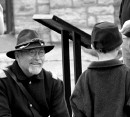WESTON PARK: A FOND FAREWELL TO OLD FRIENDS AND A HELLO TO NEW
An American Civil War Reenactment in England, reported from an English Perspective.
by Lawrence Hatter
I was asked to write a short piece on my impressions of Weston Park, so as to bring in a different perspective, that of a Confederate and an Englishman. I have been re-enacting the Civil War in Britain for around six years, since I was 15, as a Confederate artilleryman. But now at the ripe old age of 21 I have crossed the great Atlantic to join my fiancé and to read an M.A. in History at the University of Missouri-Columbia (and to join Company K, 1st Mo. Lt. Arty.). Weston Park was to be my last event re-enacting in Britain for a long while.
The event, which is held outside Birmingham, Britain’s second city, is about as large as American Civil War re-enactment gets in the U.K. I’m not certain of the numbers, but I’d estimate there were at least 800-1,000 re-enactors there (I hate estimating!). I had attended the event back in 1997, but had missed the subsequent ones mainly due to it being too far north, and therefore terribly uncivilized! Not to mention hard to get to for a non-driver. The scenario was to be the Second Manassas, but as the English terrain is quite different from America, I have no idea what it looked like to our American visitors!
I arrived on Friday afternoon after a five-hour train journey to join my old friends of the Palmetto Sharpshooters. Despite being an artilleryman, my battery was not in attendance, so I joined the footsloggers as a colour guard. It was a very pleasant evening, as despite the heavy rain I was in the excellent company and had visited the beer tent/stables sufficiently to numb the effects of the weather.
The next day the weather was changeable but generally dry. I endured the foot drill of the infantry and we went into battle in the early afternoon. The first day seemed fairly static, but with plenty of powder burnt. One of our guys, Corporal Steve Boulton got off around seventy rounds in around about an hour. Not too much to do as colour guard. I prefer life in the artillery. The evening was once again spent in the beer stable with a delightfully vulgar “country” band. Our northern brethren in Britain who re-enact have a little too much of the cowboy about them! I also had the honour of meeting up with up with the illustrious Captain Baehr and his family. I sojourned back to the Palmetto mess tent and we partook of a bottle of the cheapest Port money can buy, until the very early hours.
The second day, Sunday, was reasonably sunny. The ACWS (the society hosting the event) had a postal service, which was quite fun. We wrote abusive notes to our friends (and the adjutant of the 2nd South Carolina, who didn’t find it quite so funny!), and waited for the mail call. The second battle went at a slower pace, but with more movement. I believe Capt. Baehr had some trouble with some rebel infantry and losing the guns he served on. That is of course just a rumour. The final evening was more melancholy as the event drew to a close. The next morning I bade farewell to some very good and old friends, and decided to cross the lines to join the Army of the Republic.
It was in general, a good event but not long enough. Typical of many events really. I certainly look forward to joining my new comrades, and to fight against the evil secesh! You don’t know how bad they are unless you’ve been one!!
This article was originally published in the September 2001 issue of The Shrapnel, the newsletter of the Turner Brigade. For information about The Shrapnel, contact Sheila Porter, Editor.


